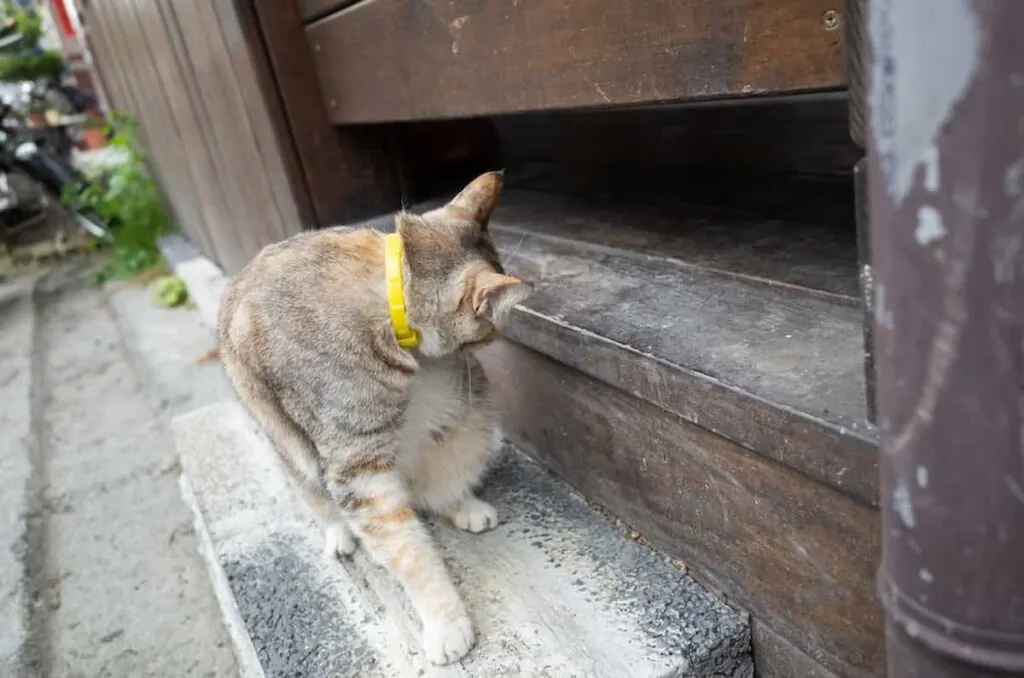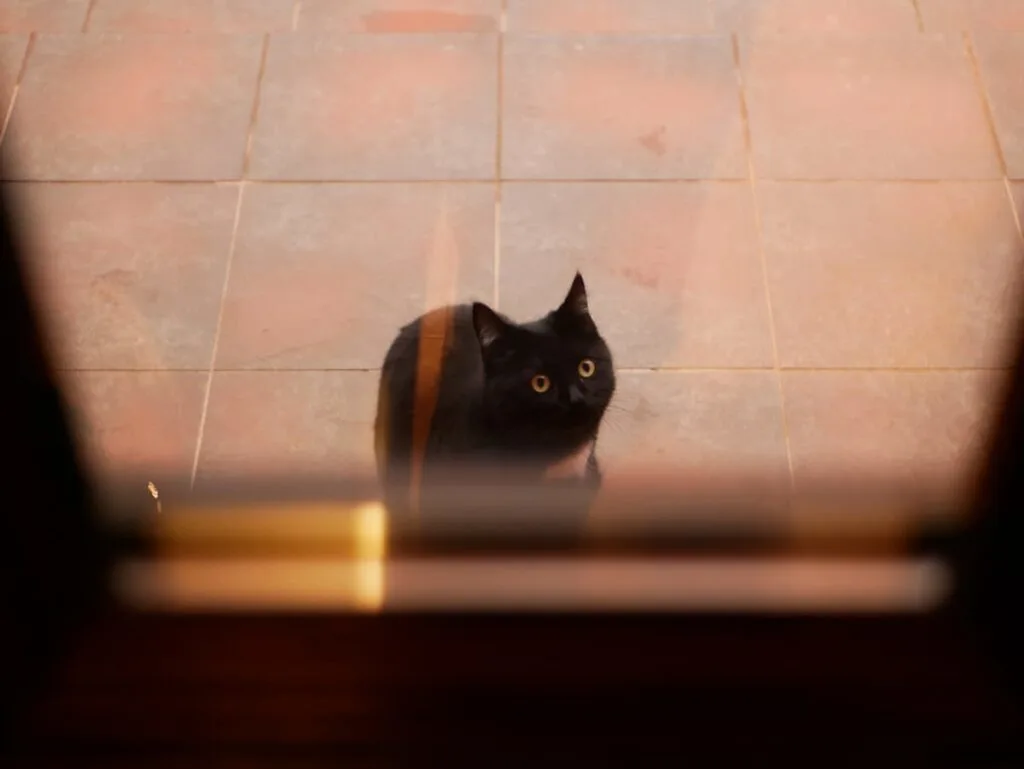Have you ever wondered how cats can fit through such small spaces? It’s common to see cats slipping effortlessly underneath doors or squeezing into tight spaces. But how do they do it?
Cats have a unique ability to contort their bodies in impossible ways. They can fit through openings that are only a fraction of their size, making it possible for them to escape danger or hide in tight spaces. This ability is due to their flexible spine and collarbone, which allows them to compress their bodies and squeeze through narrow gaps.
But there’s more to it than just a flexible spine. Cats also have powerful muscles and excellent balance, allowing them to maneuver their bodies in ways humans cannot. They can twist and turn their bodies mid-air, land on their feet, and squeeze through tight spaces without getting stuck. It’s an impressive feat that has fascinated cat lovers for centuries.

What Aids Cats In Fitting Under Doors
To better understand how a cat can easily fit under doors, we need to look at all the factors aiding them in the process. This means looking at their anatomy as their flexible spines and overall small body frame.
Flexible Spines
Cats are known for their incredible flexibility, which allows them to fit into small spaces, including under doors. This flexibility is due to their unique spinal structure.
Unlike humans with a rigid spine, cats have a highly flexible backbone of 48 to 53 vertebrae. These vertebrae are separated by discs that act as shock absorbers, allowing the spine to bend and twist in ways that would be impossible for a human.
Another factor contributing to a cat’s flexibility is that its vertebrae are not all the same size. The vertebrae in a cat’s neck and lower back are longer and more flexible than those in the middle of their back, which allows them to contort their bodies into all sorts of odd shapes.
Small Body Size
In addition to their flexible spines, cats’ small body size also plays a role in their ability to fit under doors. Most cats weigh between 5 and 15 pounds, so they can squeeze through openings only a few inches wide. Their small size allows them to contort their bodies in ways larger animals cannot.
One reason cats can fit through such small spaces is their lack of collarbones. Unlike humans, who have collarbones that limit the width of their shoulders, cats have a shoulder girdle that is only attached to their spine by muscles and ligaments. This allows their shoulders to collapse inward, making it easier for them to squeeze through tight spaces.
Finally, cats’ paws are designed to help them fit through small openings. Their front paws are incredibly flexible and can be rotated to fit through narrow gaps, while their hind paws are narrower than their front paws, which allows them to slip through tight spaces more easily.

How A Doors Design Impacts A Cat’s Ability To Fit Under It
While cats are flexible, not all doors are the same. Some doors they can’t fit under due to its design. However, it’s a major factor with the ones they can fit under. Things such as how much clearance is available, the gap size, and more all play a role. This information is p
Clearance
One of the reasons why cats can fit under doors is due to the clearance between the door and the floor. Doors are designed with a gap between the bottom of the door and the floor to allow for easy opening and closing. This gap can range from a few millimeters to several centimeters, depending on the type of door and its intended use.
This clearance is enough for cats to squeeze their bodies through. The average clearance for most doors is around 1-2 inches, with plenty of space for a cat to fit through. However, some doors may have a smaller clearance, making it difficult for larger cats to fit through.
Gap Size
Another factor contributing to a cat’s ability to fit under doors is the size of the gap between the door and the frame. Even if the clearance is large enough, if the gap is too narrow, a cat may not be able to fit through.
The gap size can vary depending on the type of door and its intended use. In general, interior doors tend to have smaller gaps than exterior doors, as they do not need to provide as much insulation or security. However, some doors may have larger gaps to allow for ventilation or to accommodate thicker flooring materials.
When installing a cat flap or door, it’s important to consider both the clearance and the gap size to ensure your cat can easily access and navigate through the door.
Overall, the design of doors plays a significant role in a cat’s ability to fit under them. By understanding the clearance and gap size, you can better accommodate your furry friend’s needs and ensure they can move freely throughout your home.

Tips for Keeping Cats Out
If you want to keep your cat out of a specific room or area, there are several methods you can try. These tips can help you discourage your cat from entering unwanted spaces:
- Shut the Door: The most straightforward way to keep a cat out of a room is to shut the door. This method is simple and effective, but it may not be practical if you need to keep the door open for ventilation or other reasons.
- Use a Cat-Proof Barrier: If you need to keep the door open, you can use a cat-proof barrier to block your cat’s access. You can use a baby or pet gate to keep your cat out while allowing airflow. Alternatively, you can use a screen or a mesh to cover the doorway.
- Try Scent Repellents: Cats are sensitive to smells, which you can use to your advantage. You can repel your cat with natural scents like citrus, lavender, or eucalyptus. You can also try commercial cat repellents that use natural or synthetic scents to keep cats away.
- Use Motion-Activated Devices: Motion-activated devices can startle your cat and discourage it from entering an area. You can use motion-activated air sprays, alarms, or water sprays to keep your cat away from unwanted spaces.
- Train Your Cat: If you want to permanently keep your cat out of a specific area, you can train it to avoid space. You can use positive reinforcement techniques to encourage your cat to stay away from the area, such as rewarding it with treats when it stays out of the space.
Remember that cats are curious and persistent animals, and it may take some trial and error to find a method that works for your cat. Be patient and consistent, and keep going even if your first attempt doesn’t work. With some effort and creativity, you can keep your cat out of unwanted spaces and create a harmonious living space for you and your feline friend.

My name is James, and welcome to FAQCats!
Along with our team of cat owners, expert pet enthusiasts, and pet professionals, we aim to write engaging helpful, engaging content about cats. At FAQCats we strive to provide content that’s accurate and fun to read. Our team writes about everything related to cats; even the most complex of topics. Through extensive research and caring for our own fur-pals, we’re able to provide something cat owners worldwide will love. Have a look around, and leave us feedback anytime!

